Demonstrating the value of SEO can be tricky. But what if there was a way to attach it to meaningful business objectives?
In this article, you’ll learn all about SEO goals and why they’re important. You’ll also get tips on how to choose the right goals and align them with your company’s needs.
What Are SEO Goals and Why Are They Important?
SEO goalsare outcomes you want to achieve using search engine optimization tactics.
SEO goals are important because they help you determine what success looks like for your business. Tracking them also enables you to monitor your progress and, if necessary, make adjustments to your strategy.
Hitting them involves SEO techniques to make your website more appealing to users and Google’s search algorithms.
For example, your strategy may involve creating keyword research-based content that ranks highly on search engine results pages (SERPs).
If done well, your content should show up in the organic search section of the SERP:
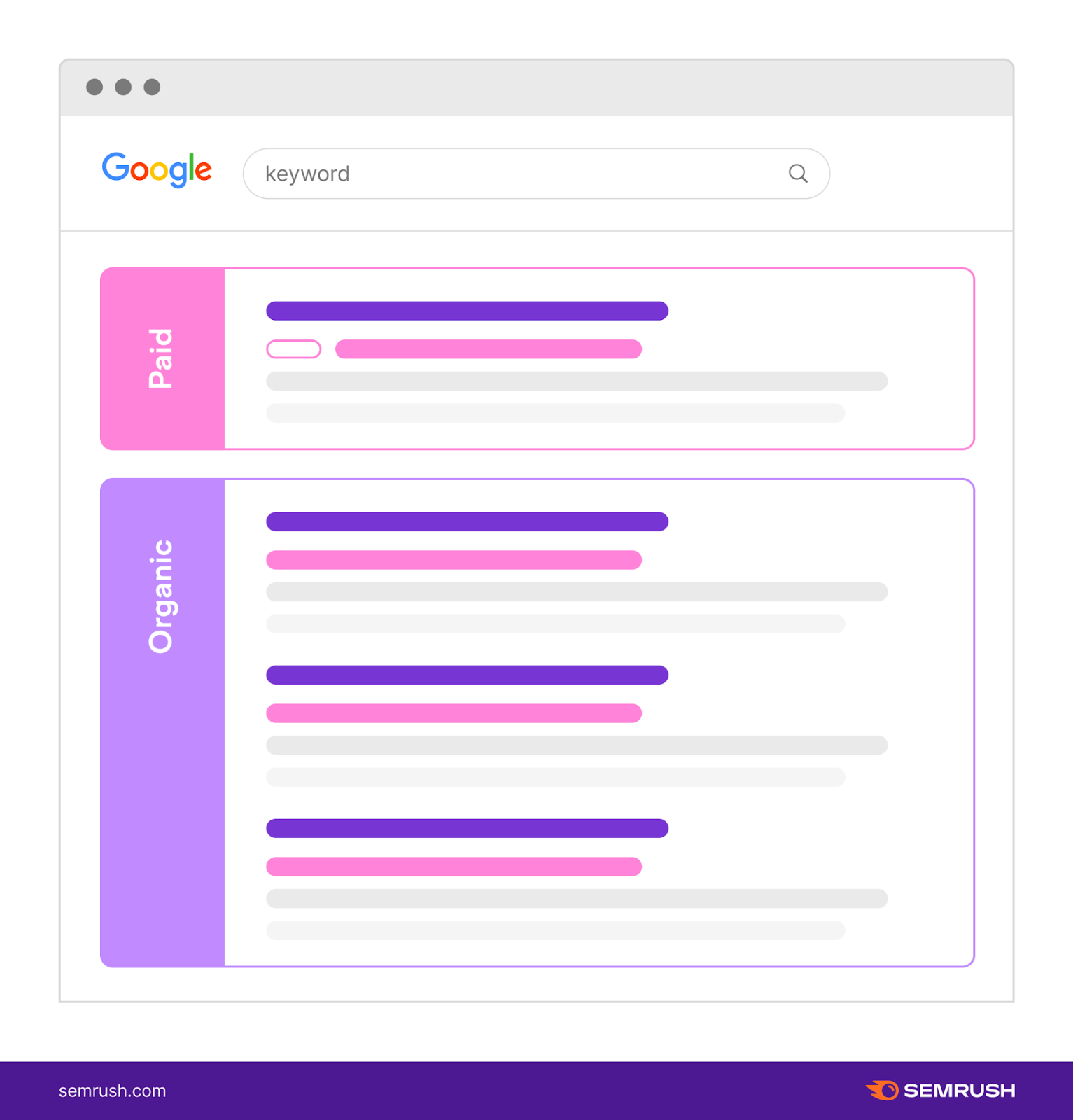
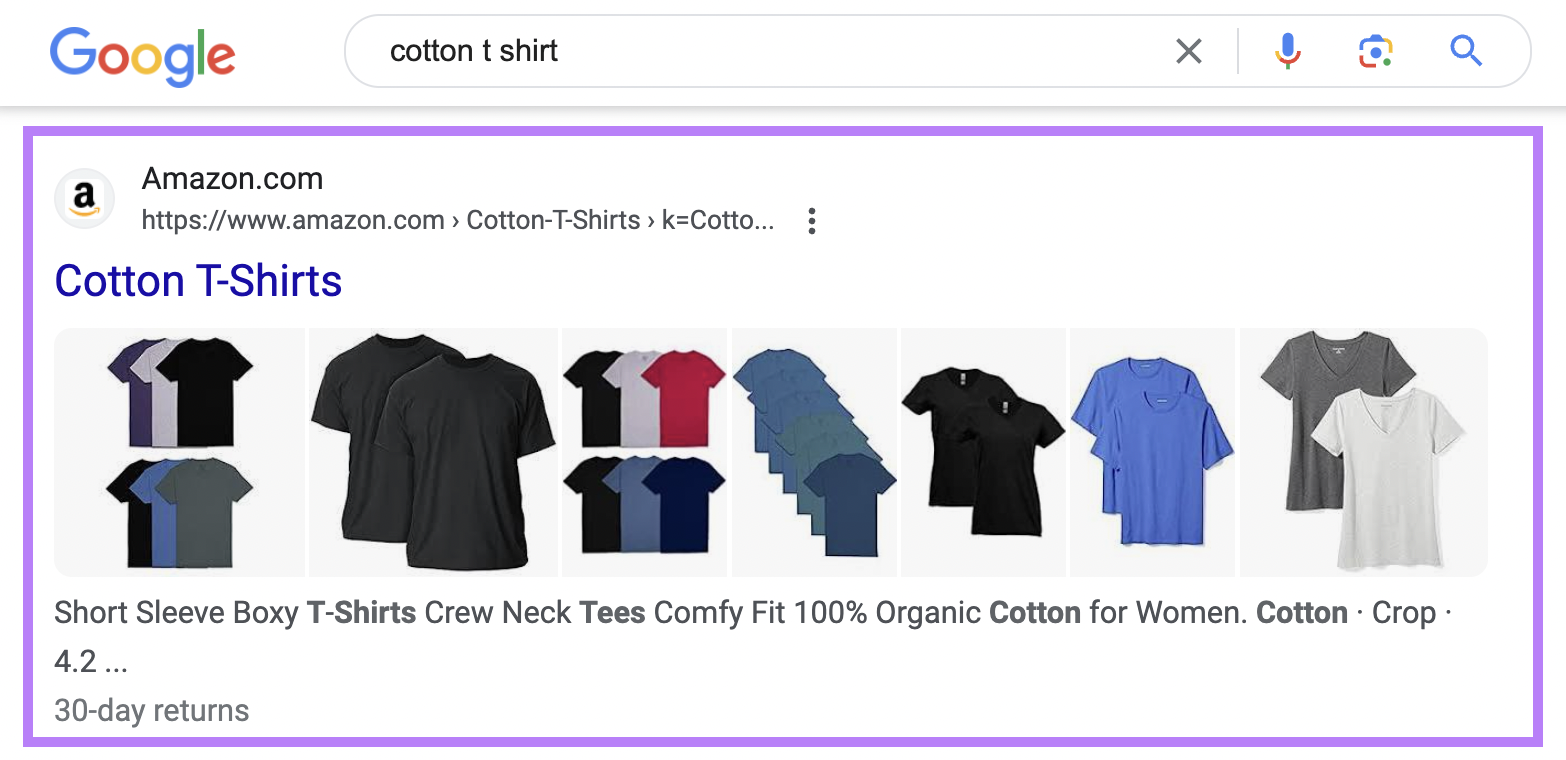
Let’s take a look at why you need SEO goals and how to set them.
How to Set SEO Goals
To set SEO goals that support meaningful business objectives, choose relevant goals and then make them actionable.
Start by establishing where you are now.
Current performance metrics act as benchmarks to help you determine where you stand. They also allow you to measure progress accurately.
Next, come up with your key performance indicators (KPIs). These are quantifiable metrics that help you evaluate your SEO performance efforts.
For example, here are 12 SEO KPIs you may want to track on the road to more conversions:
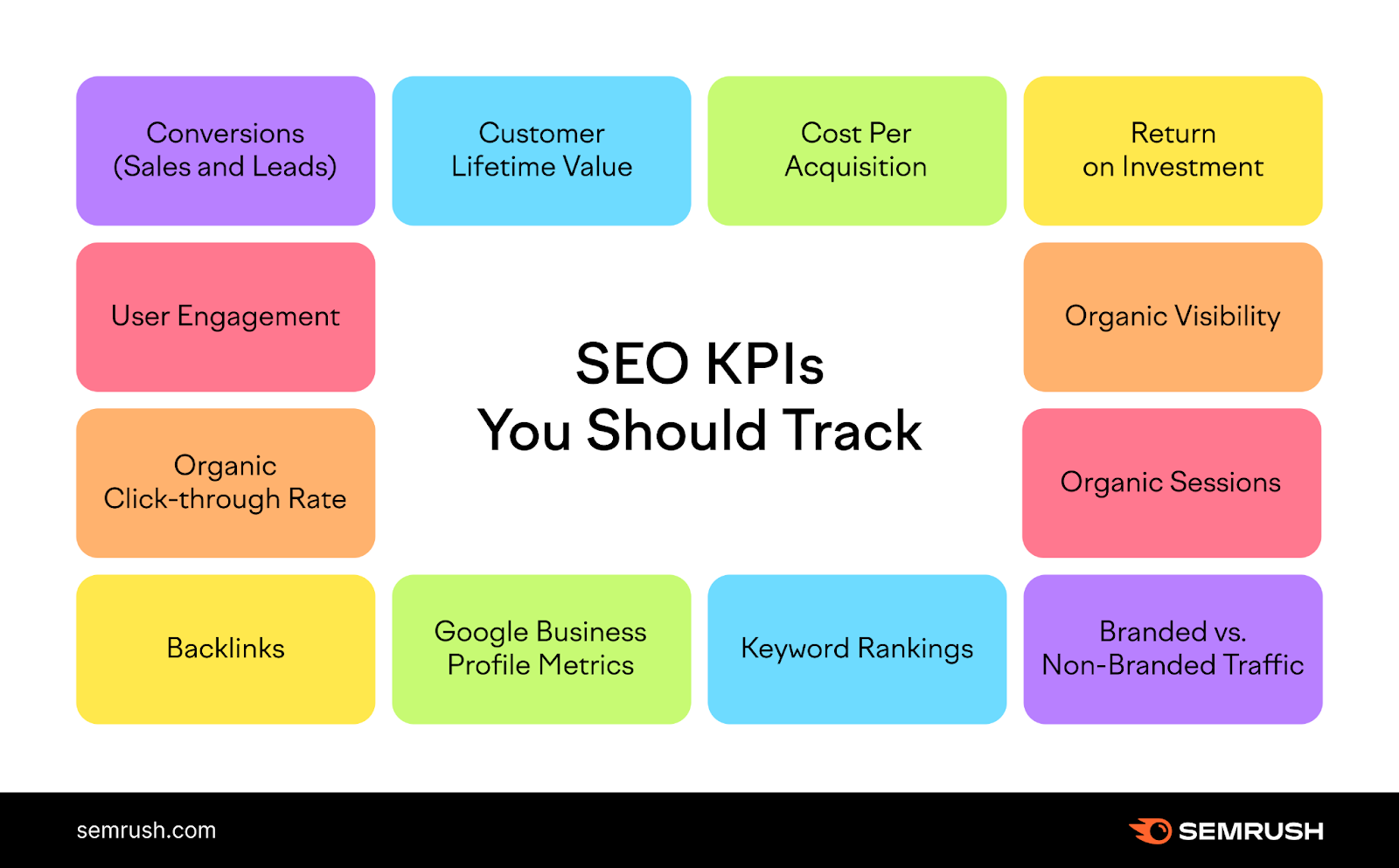
Let’s look at keyword rankings as a KPI.
Keyword rankings are an indication of which keywords are driving your traffic and why. It was also the top metric SEO pros used to measure performance in 2022.
So how do you use this KPI to support your goals?
Say you set an SEO goal to double organic traffic to your website in six months. To make that happen, you need to improve your site’s visibility in the SERPs by ranking for specific keywords.
You may currently be ranking in the top three SERP results for just three keywords. That’s your benchmark.
To reach your desired outcome of getting more traffic, you may set a KPI to rank in the top three organic positions for 10 target keywords within four months.
Establishing benchmarks and going after specific KPIs will give you direction and help you see that you’re progressing toward your SEO goals.
6 SEO Goals to Help You Grow Your Business
The SEO goals you prioritize will be unique to your business. But there are five basic goals that most websites aim for.
All of these goals are interrelated. By improving one, you’ll likely have a positive impact on the others.
1. More Organic Traffic
Increasing organic traffic is a common goal for boosting SEO success. The more people who visit your site and content, the more potential customers you have.
And the more traffic you generate, the more search engines will register your content’s value. Which increases your chances of ranking well.
You want your goal to be specific. For instance, “Increase organic traffic by X% over the next year.”
How do you determine your specific target percentage?
Start by taking a look at past growth. You can use a tool like Google Analytics 4 (GA4) to analyze your site. Once you have your account set up, go to “Reports” > “Acquisition” > “Traffic Acquisition.”
You’ll see a chart like this at the top of the report:
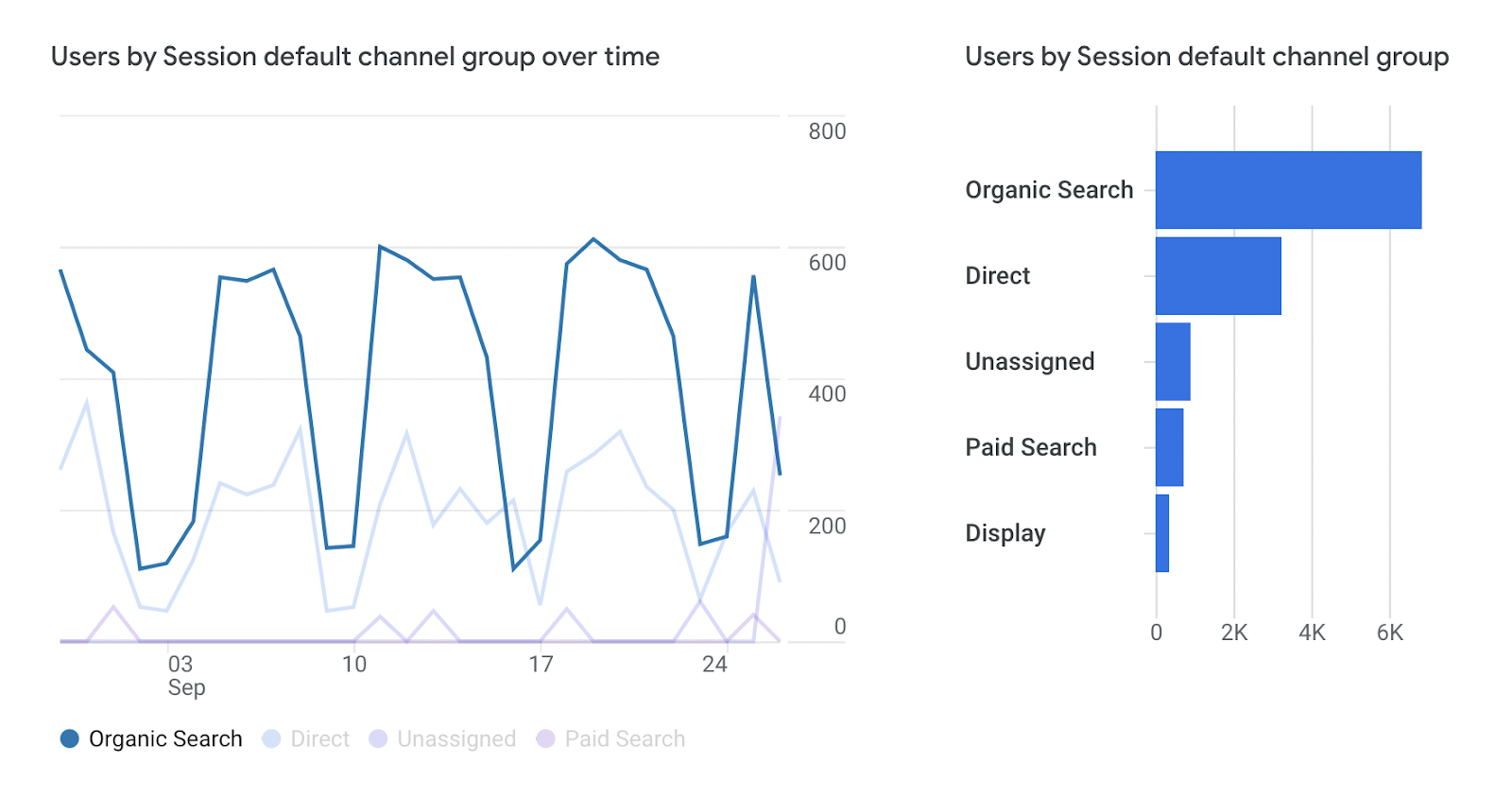
This will give you an idea of how your site has performed recently. You can then base your goals off of that information.
For instance, say you had an increase of 5% over the previous year. You want to see improvement, so you might set a goal to increase by 8–10% over the next six months.
You can then decide on specific SEO techniques to boost organic traffic and track the relevant KPIs to make sure you’re making progress toward your goal.
2. Better Backlinks
Backlinks are links that point from one site to another. Google views these as votes of confidence for your site, so sites with lots of quality backlinks often rank higher in search engines.
As a bonus, more backlinks also means more referral traffic from other sites.
So getting more backlinks (or more high-quality backlinks) can be an important SEO goal.
Let’s say your SEO goal is to add 50 backlinks to your link profile in the next six months.
Which KPIs might help you achieve organic traffic or backlink-related goals?
You want to focus on link-building tactics.
These could include creating a ton of high-quality content, sending out press releases to relevant news outlets, or emailing influencers to ask for quotes.
Resources like Semrush’s Link Building Tool can help you quickly build backlinks for your site.
For instance, here’s a sample email template from the outreach module:
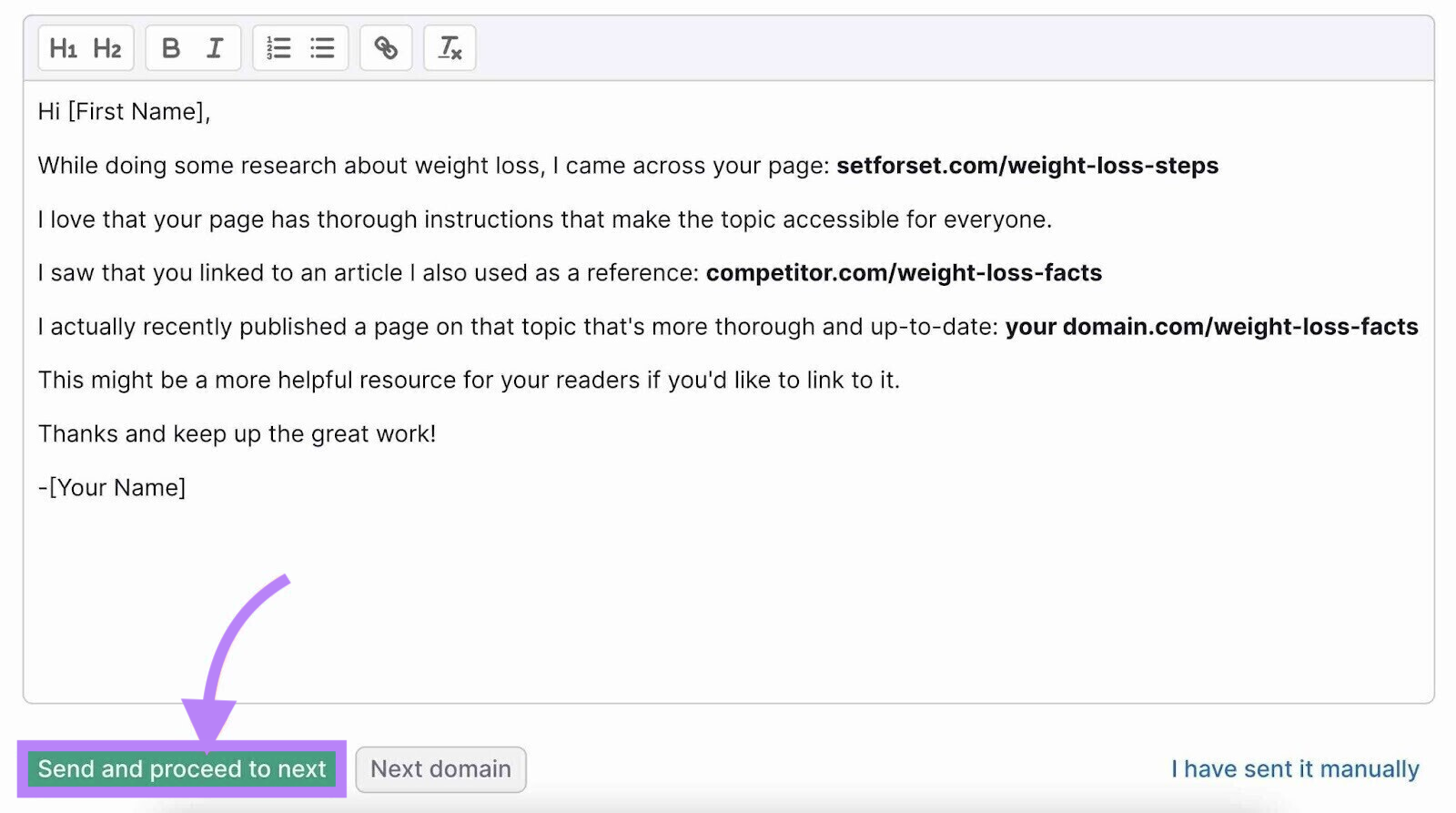
You can use the template to quickly send out requests for backlinks and track responses.
You will set KPIs based on the tactics you choose. For instance, KPIs for boosting backlinks might include increasing your email outreach efforts by 5% in three weeks
3. More Leads and Conversions
The most important SEO goal for your business is organic conversions. This includes sales, leads, and subscriptions.
Conversions happen when a prospective customer takes a desired action. For instance, a website user becomes (or “converts” to) a subscriber. Or a subscriber becomes a buyer.
These actions move prospective or current customers down the marketing funnel.
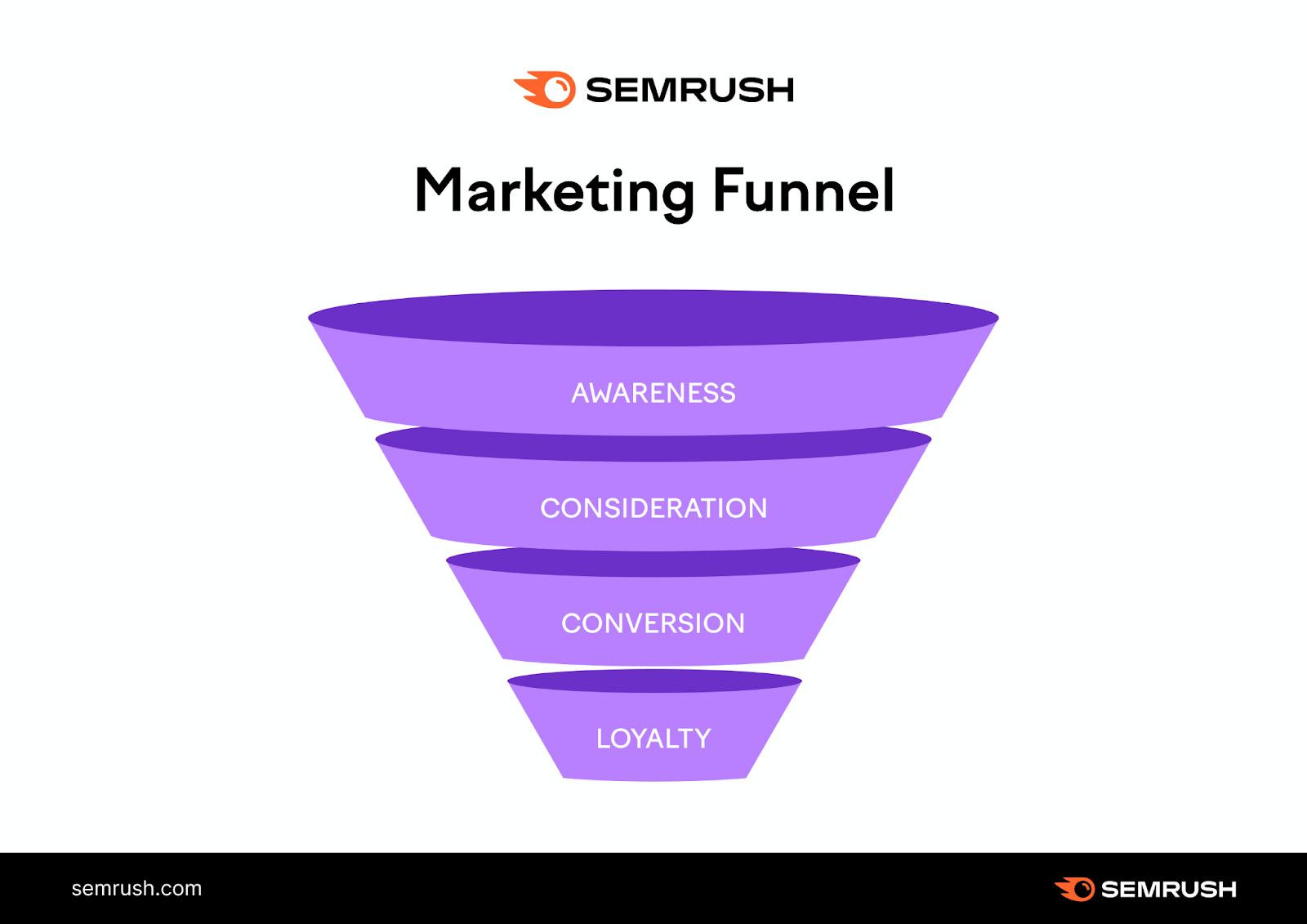
Conversions can include someone scheduling a demo, signing up for a free trial, or making a purchase.
One of your specific SEO goals may be to increase your conversion rate by 1%.
To get more conversions, you need more qualified leads.
Qualified leads are potential clients that have shared personal data while engaging with your content. They are most likely to become conversions because they’ve already shown specific interest in what you’re offering.
Gated content like ebooks, whitepapers, and courses help to collect this information. You can also get leads from signups for email newsletters.
Newsletter signups can double as both leads (from the data input) and conversions (if your goal is to get an increased number of signups).
One of your strategies to achieve this could be to decrease the length of your forms. Easier checkout is a way of reducing friction for the user. Cutting down on friction helps optimize your sales funnel for better conversions.
By only asking for their name and email, you could entice more people to sign up.
Another way of increasing your conversion rate is to help your target audience find your content by using long-tail keywords.
These are more specific terms that have a lower search volume (i.e., fewer people are searching for them), but they’re often easier to rank for.
Imagine a company is looking to boost its ranking for content about iced coffee. They can use Semrush’s Keyword Magic tool to find a few examples of related long-tail keywords:
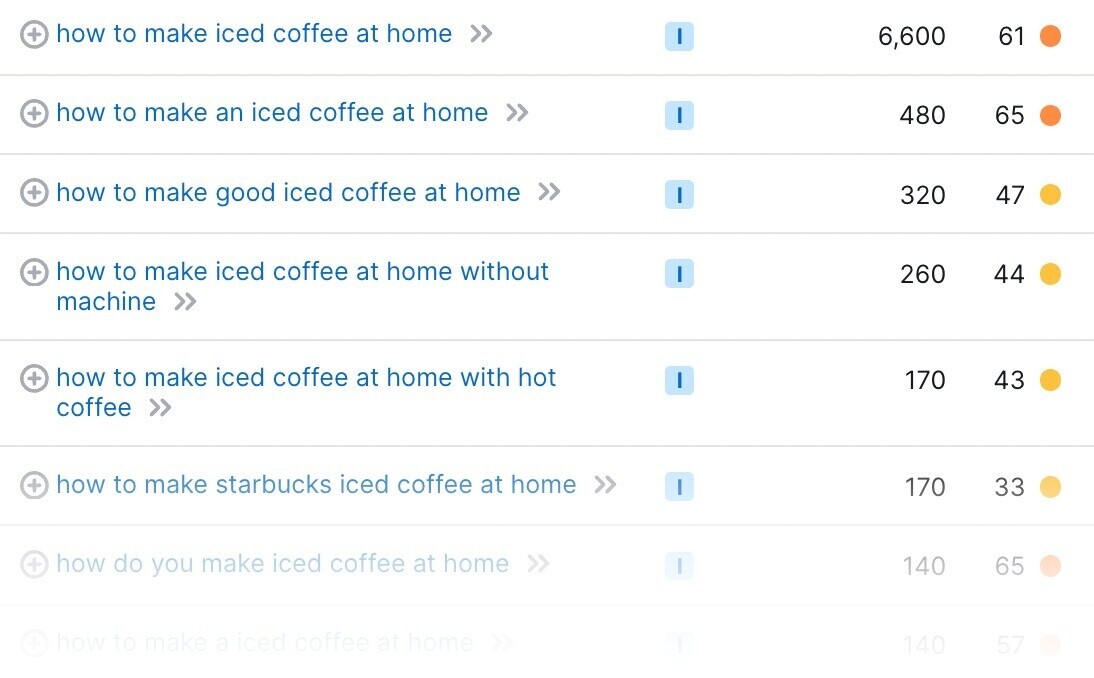
The results indicate that users searching for these terms are looking for a how-to guide and the ingredients they need.
If you serve up content that addresses their search intent, these users are more likely to purchase or otherwise convert (e.g., sign up for your newsletter or follow you for more recipes) than those simply searching for “iced coffee.”
Based on these strategies, your KPIs could include the following:
- Increase newsletter signups by 200% in six months
- Target five long-tail keywords per month with high-quality content
For any of your KPIs, remember to note down your benchmarks. That way, you’ll see which of these strategies are most successful.
4. Optimized Engagement Rate
Engagement rate measures the percentage of website visitors who interact with content on your site. For instance, by clicking a link or reading an article.
When people spend more time on page or take action, it indicates that visitors find your website and content useful. Setting a goal to boost your engagement rates can be a great way to increase your SEO success.
You can get a sense of if and how people are engaging with your site with Google Analytics. GA4 defines engagement rate as “the percentage of engaged sessions on your website or mobile app.”
It defines an engaged session is a session as one that meets any of the following criteria:
- Lasts 10 seconds or longer
- Includes a conversion event (clicking a button, filling out a form, etc.)
- Has at least 2 pageviews or screenviews.
If you’re nailing search intent and creating content your audience enjoys, they’re more likely to interact with your website.
Analyzing this metric helps you pinpoint your more interesting and valuable pieces of content. Then you can make more of the same.
You can see your engagement rate report in GA4 under “Acquisitions” > “User Acquisitions.”

You can get a sense of where you’re getting less engagement and set a goal like “Increase engagement rate by 10% for content pages over the next quarter.”
One strategy for increasing engagement is to add more engaging elements to key pages.
For example, adding a 60-second video to 20 of your low-performing articles over two months could help keep people engaged for longer.
We include the following video to demonstrate various forms of content marketing in our “What Is Content Marketing” article:

Videos can help explain your point in a more visual, engaging way.
You can also boost engagement rates by offering more focused CTAs on landing pages. For instance, by giving clear actionable instructions with a prominent link or button.
Your KPIs for optimizing engagement rates might include:
- Increase average time on page on blog articles by four minutes within three months
- Increase the number of CTA clicks on top landing pages
5. Lower Bounce Rate
Bounce rate is essentially the opposite of engagement rate. GA4 defines it as “The percentage of sessions that were not engaged sessions.”
Setting a lower bounce rate as an SEO goal means you’re creating a site that people want to come back to more regularly. This can lead to more conversions, brand awareness, and loyalty.
To set a bounce rate goal, first find your benchmark.
You can find your own metrics in GA4 (Google Analytics) when you’re looking for your benchmark:
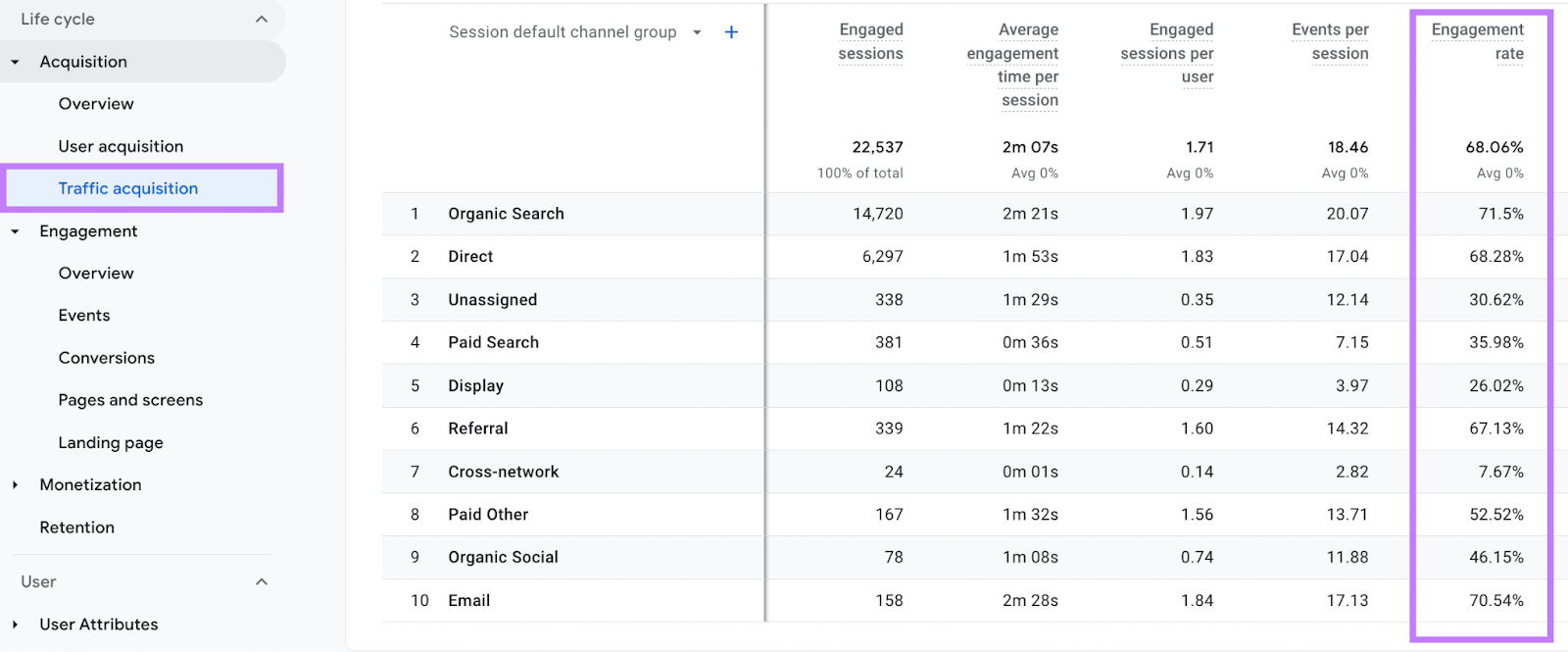
Across all sites, mobile users have an average bounce rate of 56.8%. For desktop users, it’s 50%. And for tablet users, it’s 51.6%.
However, it’s important to note that bounce rates vary by industry. So you should compare your rates to industry averages rather than all sites. If your rates are higher than the norm, you may want to set a goal to bring them more in line.
Once you know what percentage to aim for in your goal (e.g., “Reduce bounce rate by 15% over the next three months”), you can determine what strategies and KPIs you’ll employ.
Creating a good user experience means improving your content. But it also means making a better user experience. Research friction points users may be experiencing.
Here are some of the technical SEO elements that could be letting you down:
- Slow loading speed
- Low-quality webpage design
- A mismatch between content and keywords
- Poor mobile optimization
If you think your site’s load time could be the problem, check out Site Performance in Semrush’s Site Audit tool. Here, you’ll get an overview of your speed metrics:
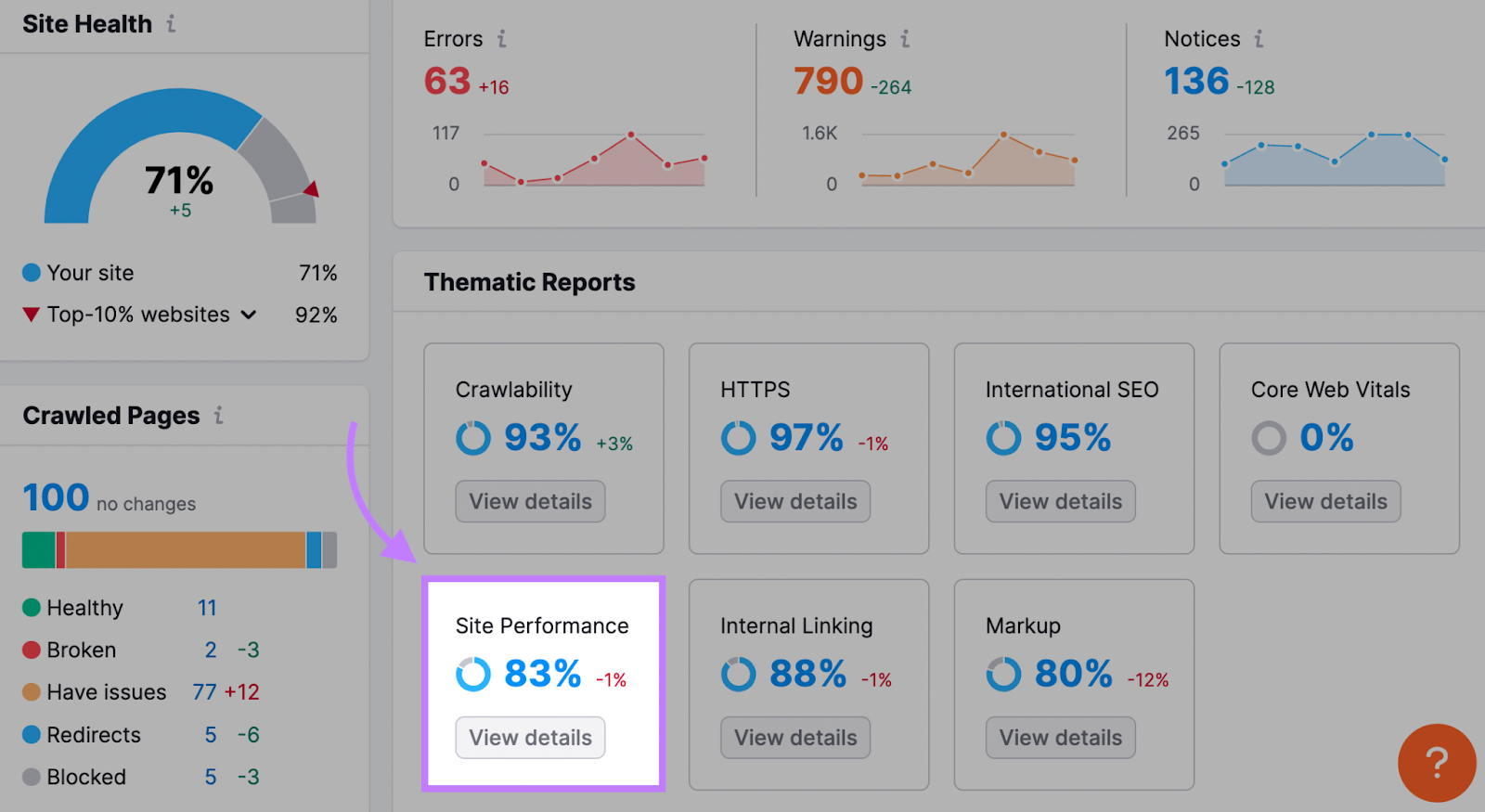
If slow loading times are the problem, you’ll get detailed tips on how to fix it.
Make the changes needed, then continue to track these metrics across the timeline of your goal.
Your industry, where your traffic comes from, and the pages where users land can also affect your bounce rate.
In one study, the science industry has the highest bounce rate for mobile users at 66.37%.

If you had a website in the science industry, you could work on ways to improve it for mobile users.
You could break up your articles into more manageable chunks for smaller screens. Or rearrange your content into pillar and cluster pages to improve your internal linking architecture and help users navigate around your site more easily.
Using the strategies mentioned above, your KPIs for reducing bounce rate could include:
- Optimize site loading speed to under two seconds in the next two weeks
- Create three topic clusters by next quarter to improve your internal linking architecture
6. Increased Domain Authority Score
Domain authority represents a domain’s perceived quality and SEO performance in search rankings. The higher it is, the greater the chance of ranking well.
And the higher you rank, the more traffic, backlinks, leads, and conversions you’re likely to get.
It’s a score from 1-100 based on a series of metrics that indicate trustworthiness and expertise in your niche.
Every SEO tool has its own name for this metric and measures it slightly differently. We call ours Authority Score.
You can find your Domain Authority Score using Semrush’s Domain Overview, Backlink Analytics, Backlink Audit, or the Link Building Tool.
Here’s what Semrush’s score looks like:
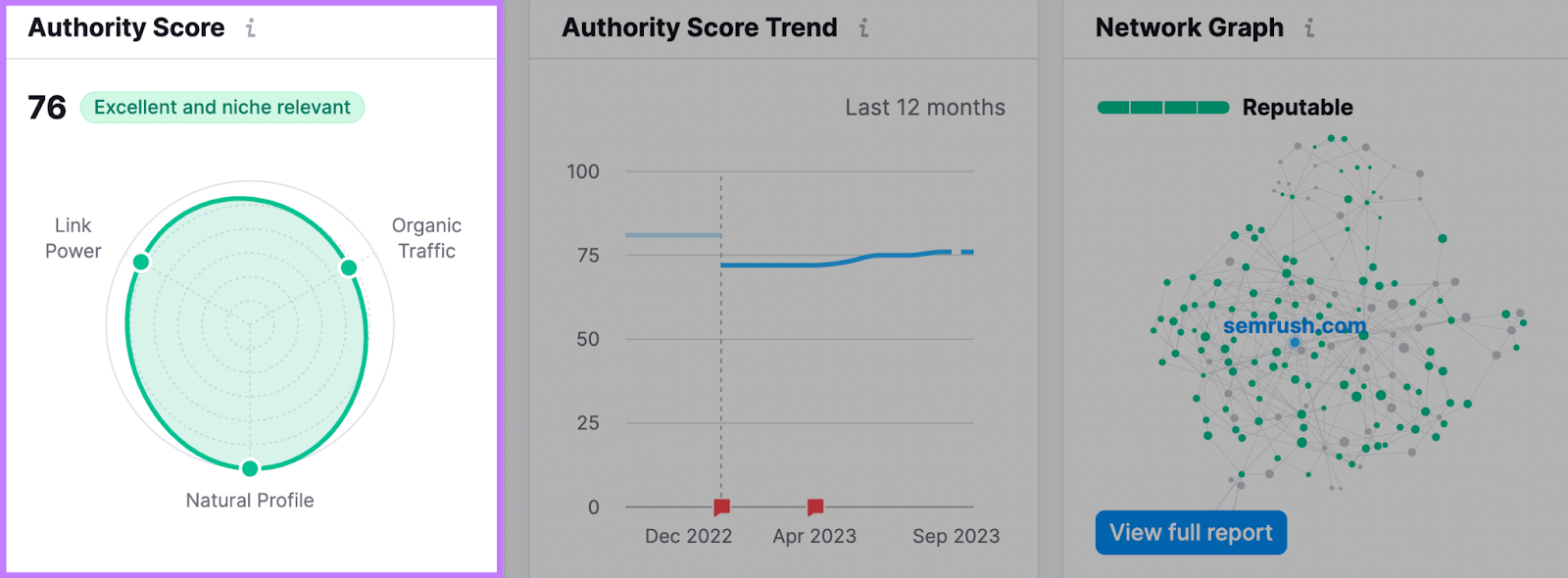
It’s calculated using AI and machine learning to measure a domain’s authority with three indicators:
- Link Power: The quality and quantity of your backlinks
- Organic Traffic: The estimated monthly average of organic search traffic
- Spam Factors: Checks that indicate a spammy or natural link profile
The goal of your SEO campaigns is to land your content in one of the top results on the first SERP.
Here’s what this looks like for the keywords “gardening tips”:

According to Semrush’s Authority Score, each of the top-ranking articles above have domain authority scores that range from “very good” to “excellent.” So you can see why it pays to have a high one.
Let’s say your SEO goal is to improve your Authority Score by five points over the next year.
You can do this in several ways, including:
- Getting more organic traffic to your site
- Building more high-quality backlinks
- Reducing spam factors in your link profile
Semrush’s score is high because traffic is “above average” with “superb” link power and a “natural profile”:
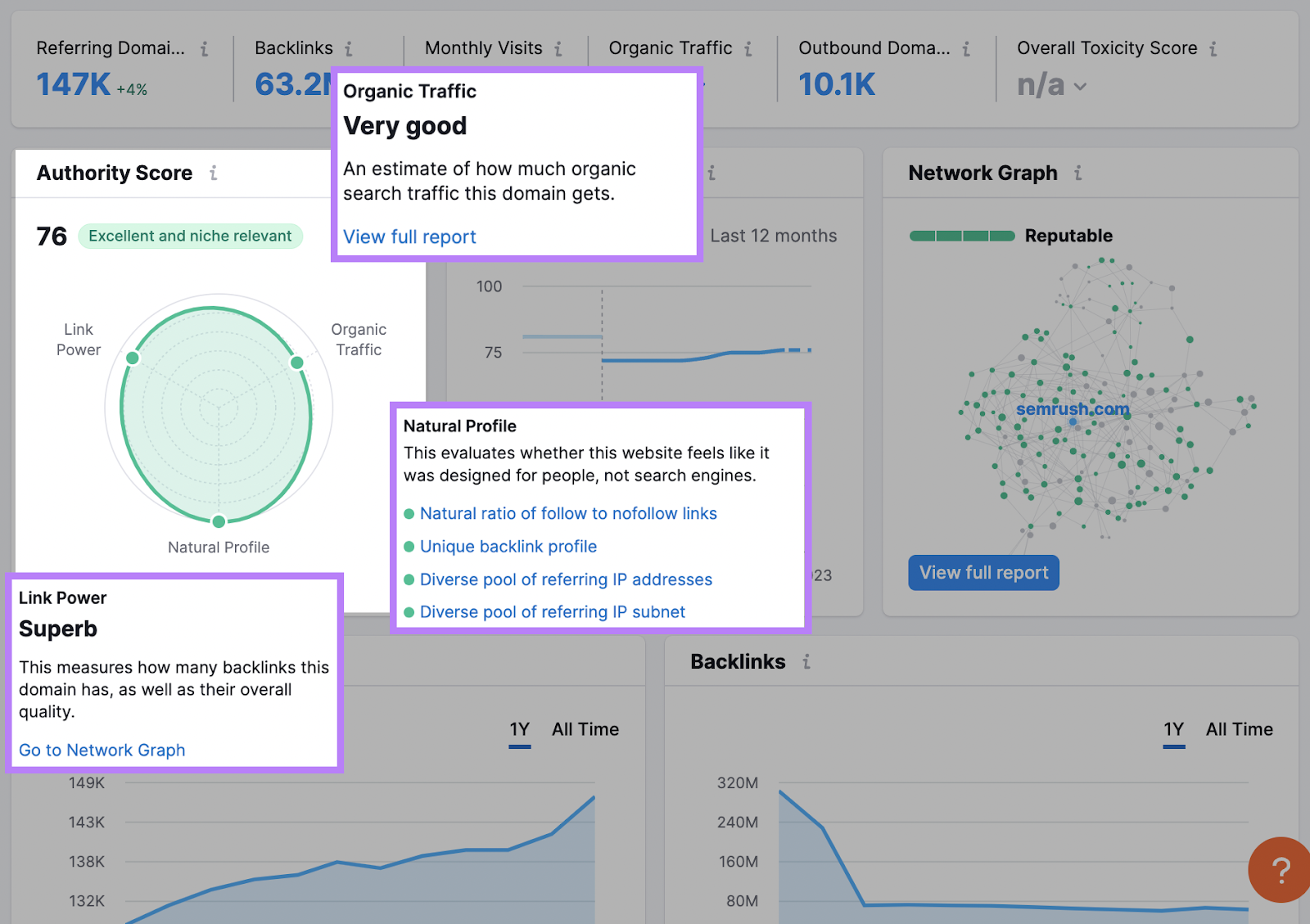
(You’ll find that setting and hitting goals related to more traffic and backlinks will naturally increase your Authority Score.)
By focusing on strategies for generating more traffic and backlinks, you could develop these KPIs:
- Drive more traffic by ranking for 15 long-tail keywords within six months
- Get 30 new listings in directories and indexes in your niche within eight weeks
In addition to taking note of your Authority Score benchmark, use your traffic and backlinks as reliable progress markers. Then see how increasing them impacts your score.
How to Align SEO Goals with Business Objectives
Aligning realistic SEO goals with broader business objectives is crucial for achieving long-term success.
It helps you demonstrate the value of your SEO strategy to make sure stakeholders understand its importance.
Here are five steps to help you do it:
Understand Your Business Objectives
Start by nailing down what it will take to grow your business.
These are your business objectives.
You’ll have broader business goals like “making more money.” But your objectives need to be more specific. These will help you target how you achieve that vision.
To make more specific, actionable objectives, follow the SMART framework. Ensure your goals are specific, measurable, attainable, relevant, and time-bound. Here’s how they relate to business goals:
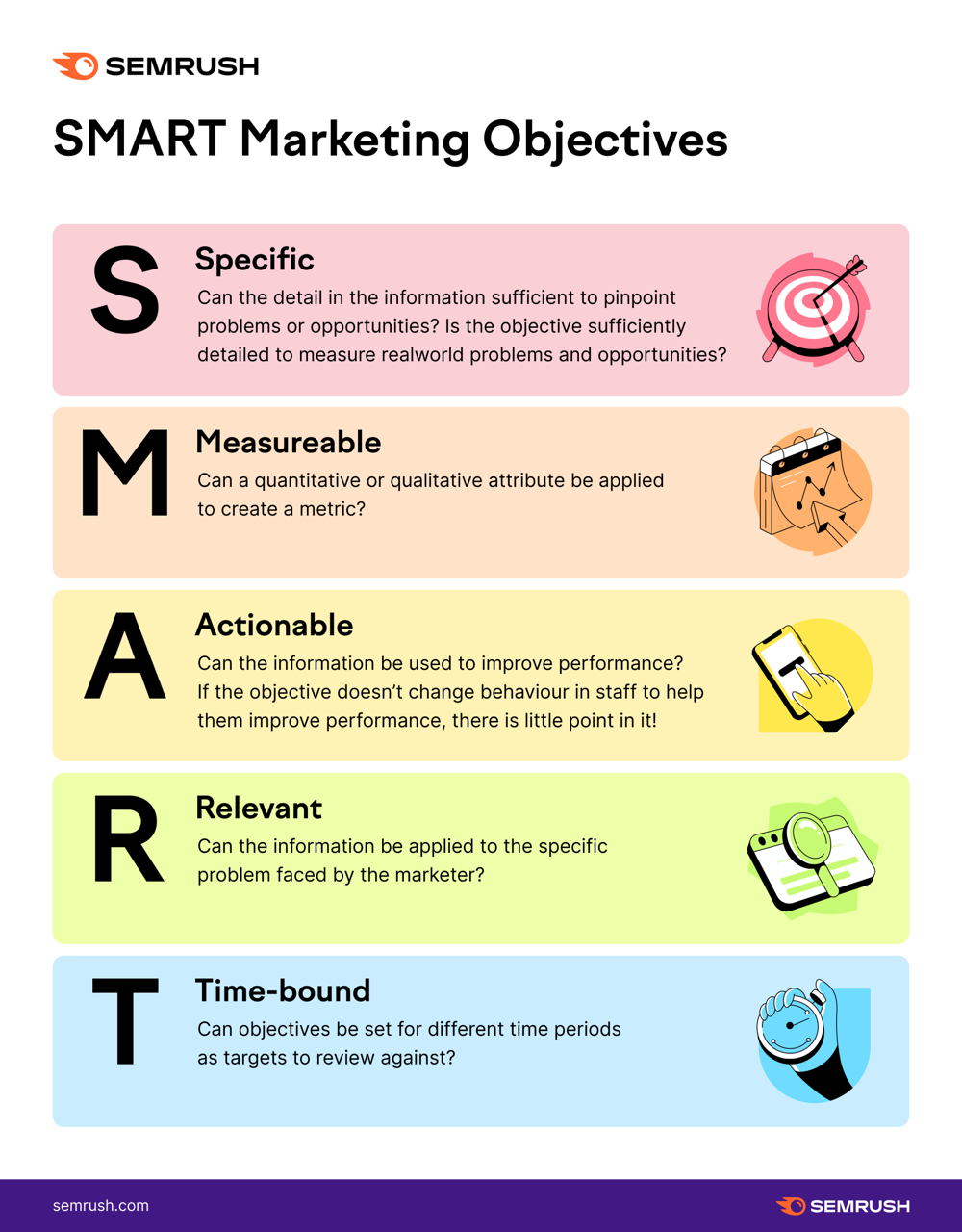
Based on this framework, here are some business objectives made SMART:
- Increase total ecommerce revenue by 40% over the next three years
- Reach 20k newsletter subscribers ahead of new product launch in two months
- Hit 40,000 monthly website visitors with organic search by the third quarter
- Increase total market share by 5% by the end of the year
Your objectives will be unique to you, but use this method to make them SMART. And note down your benchmarks for each.
That way, you have a solid starting point for tracking progress.
Choose Relevant SEO Goals
Your SEO goals must align with your chosen business objectives to demonstrate value.
If you can’t show how the strategy will help increase your market share, stakeholders may not buy in.
However, this method won’t apply to all of your objectives.
For example, let’s say you’ve decided to arrange health insurance for all of your employees by the next quarter. Unfortunately, SEO can’t help you there.
But you can attach SEO goals to the list we created above:
- More gated content marketing results in leads and conversions: Increase total ecommerce revenue by 40% over the next three years
- Better content increases time on page and lowers bounce rate: Reach 20k newsletter subscribers ahead of new product launch in two months
- More traffic and backlinks increase Domain Authority Score: Reach 40,000 monthly website visitors with organic search by the third quarter
- Optimized email outreach increases organic traffic and backlinks: Increase total market share by 5% by the end of the year
Let’s say you decide to work on your email outreach. Use Semrush’s Link Building Tool to set your benchmark so you can manage and monitor your progress.
(If it’s your first time using the tool, your benchmark will be zero.)
Head to the tool and start by clicking “Create project.” Then add your domain and give it a name to help you keep track.
Once you’ve done that, click the next “Create project” button:
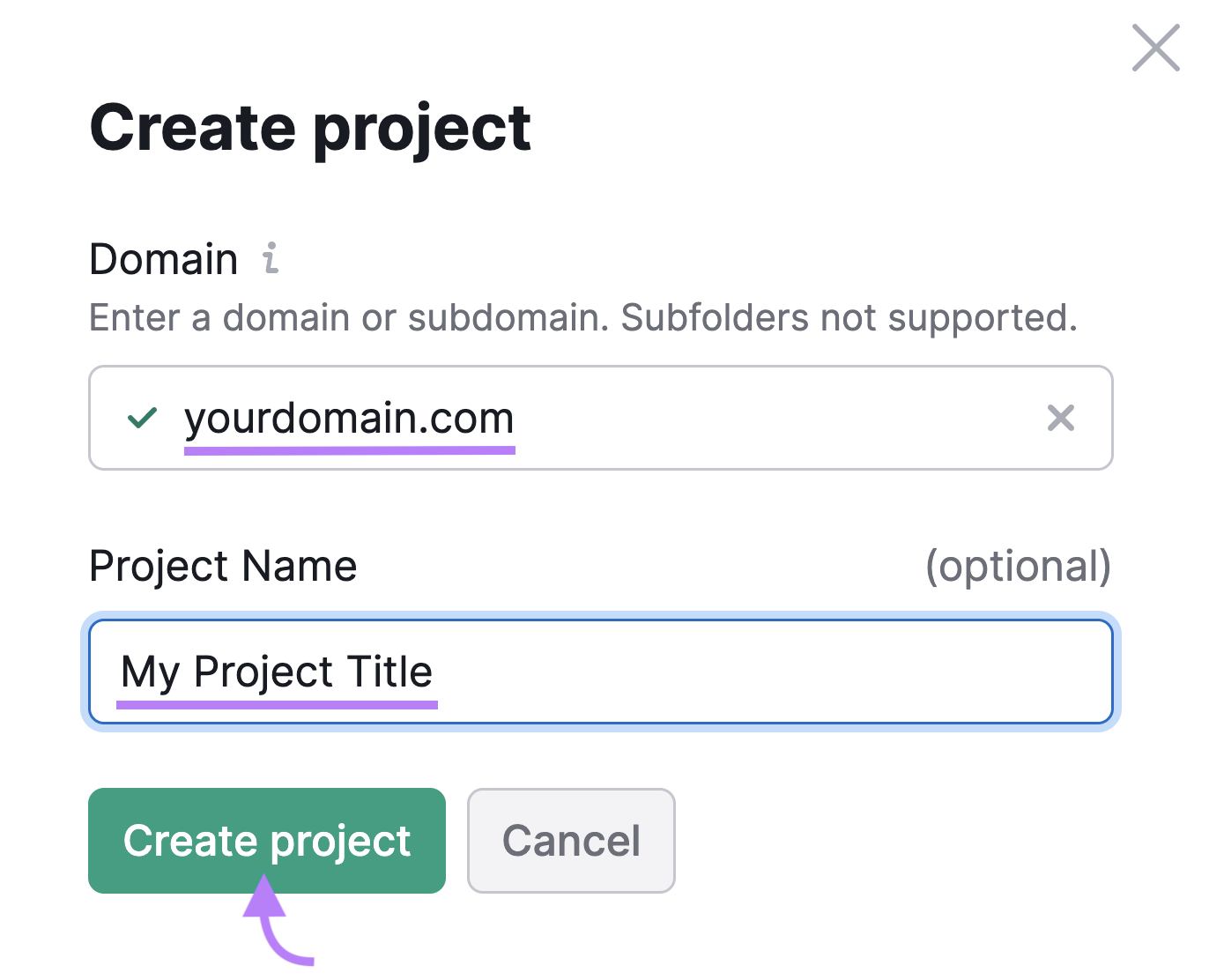
Then add keywords that relate to the page you’re trying to build links for.
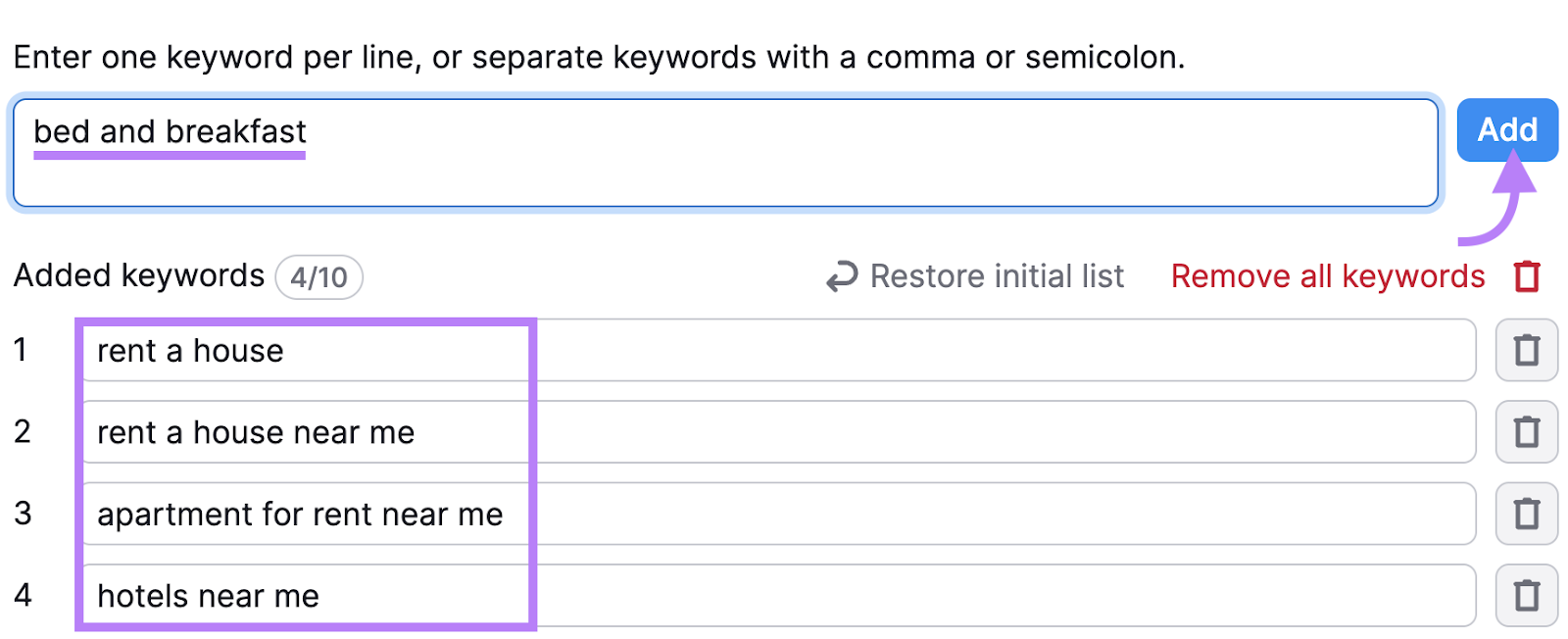
Once you’ve done that, click “Competitors” at the bottom.
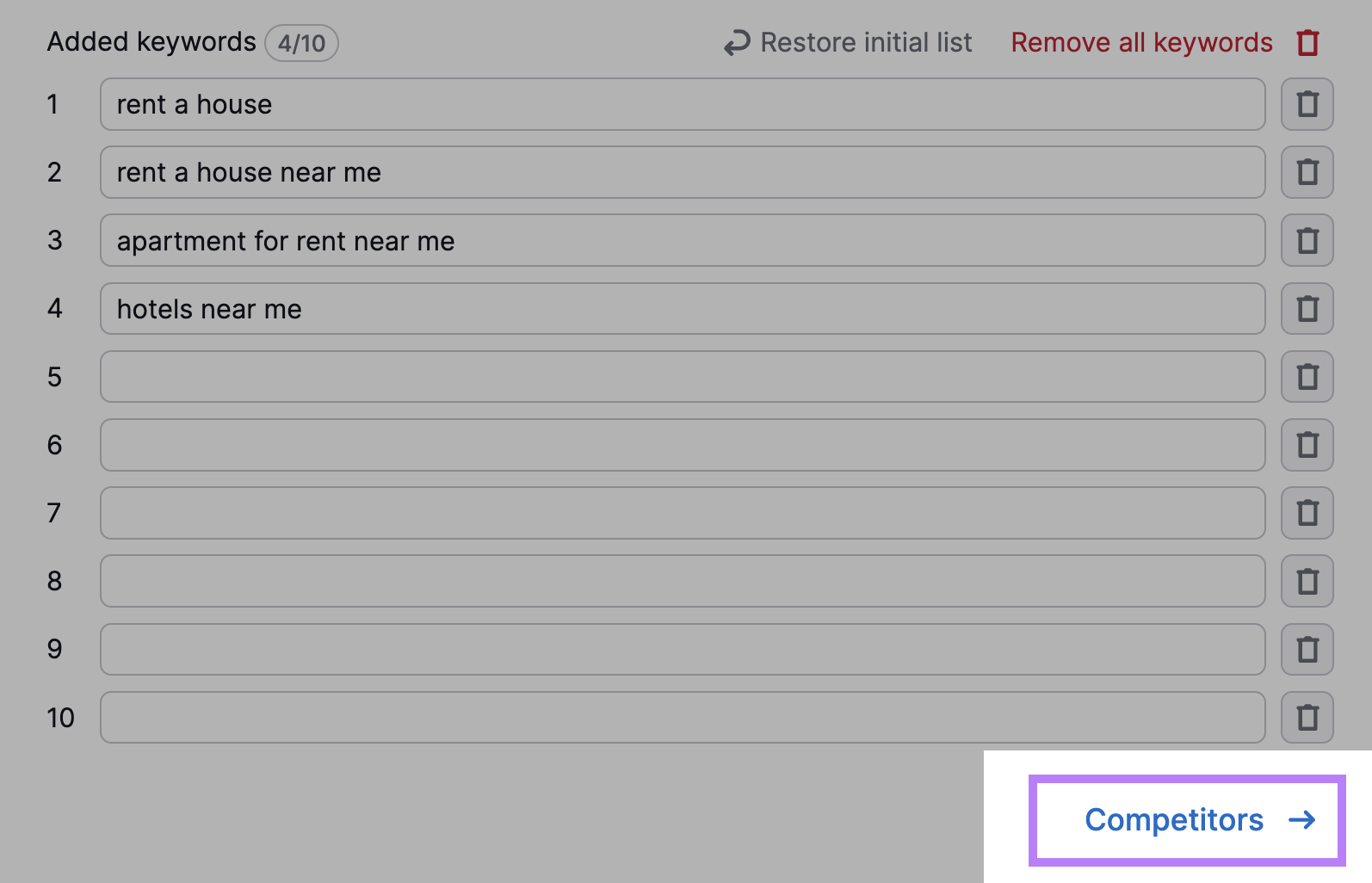
Then add the URLs of your competitors and click “Start Link Building.”
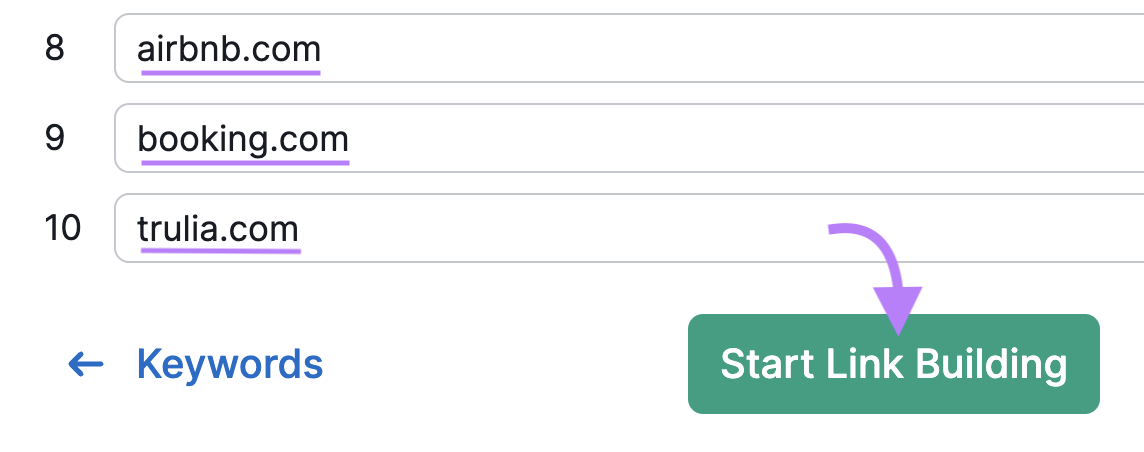
After you click “View prospects,” you’ll see everyone available to reach out to for backlinks.
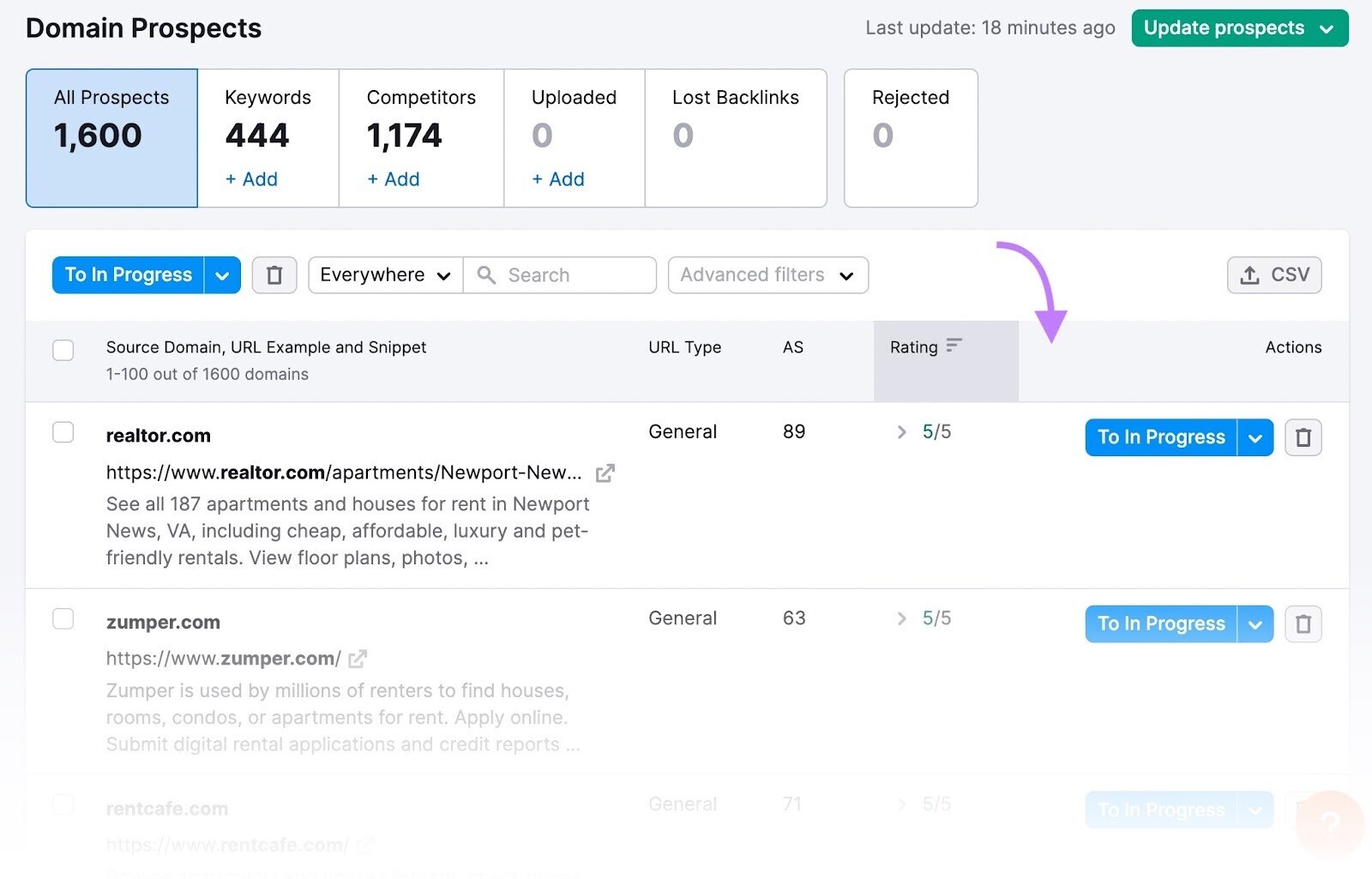
When you see those you want to reach out to, click “To In Progress” and you’ll add them to the “In Progress” tab.
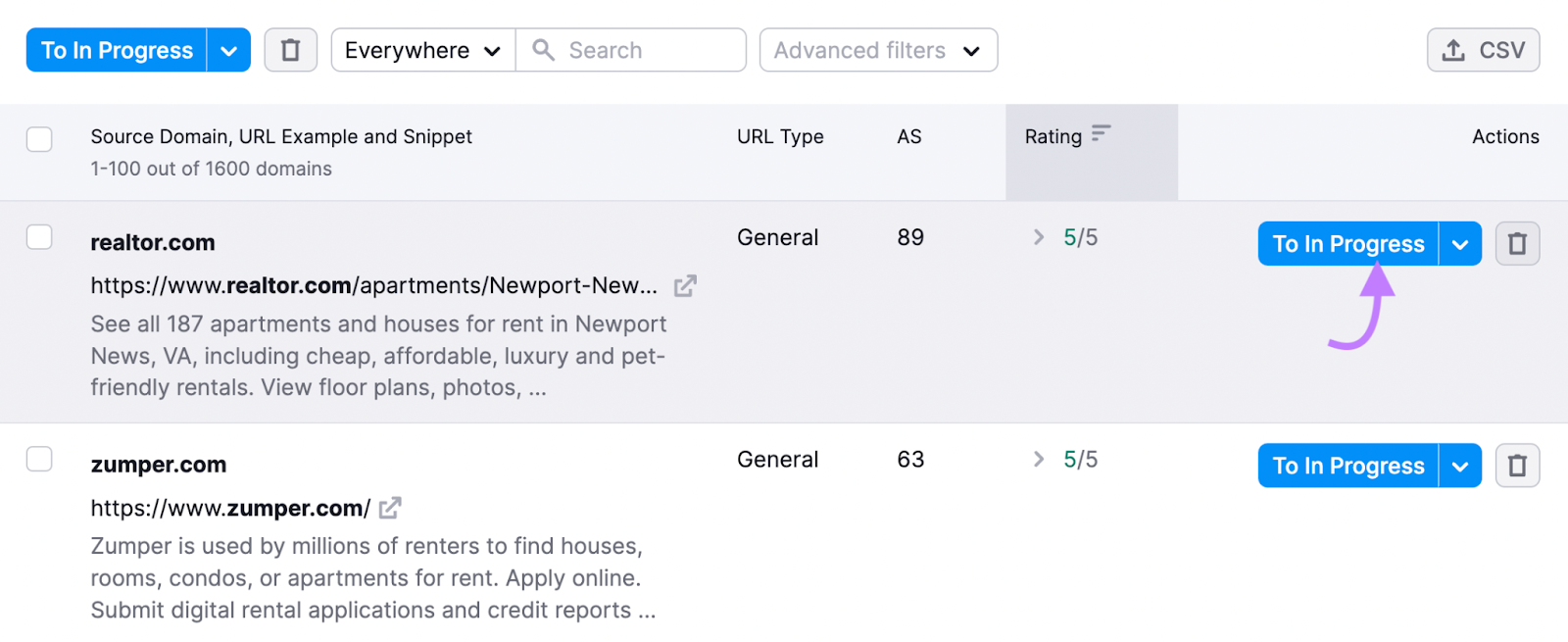
Here, you can contact prospects from a connected email account. Clicking “Contact” will show an email template with the below default information:
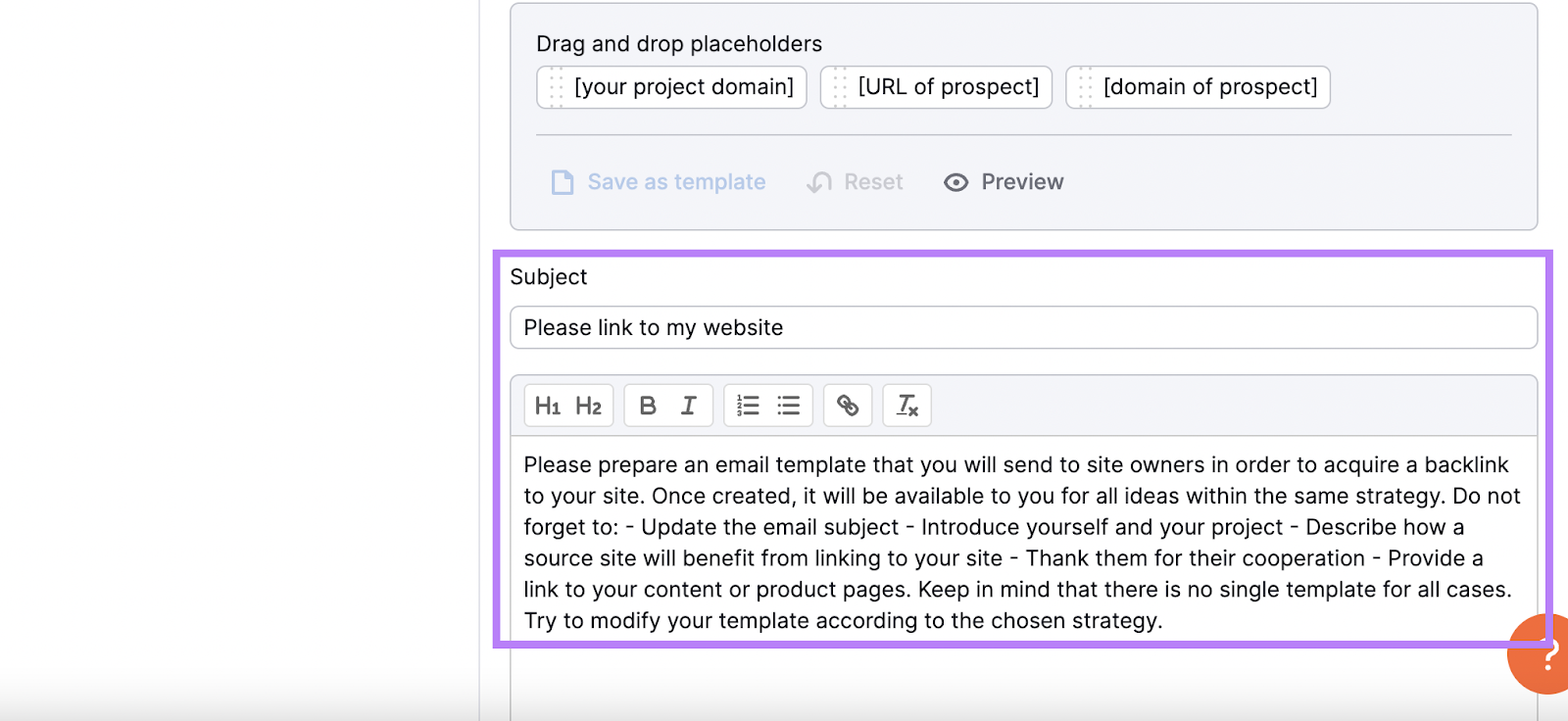
You can then customize and send your emails while the “Status” column shows whether it was successfully sent or not. You can also see if your prospect received, opened, or replied to it.
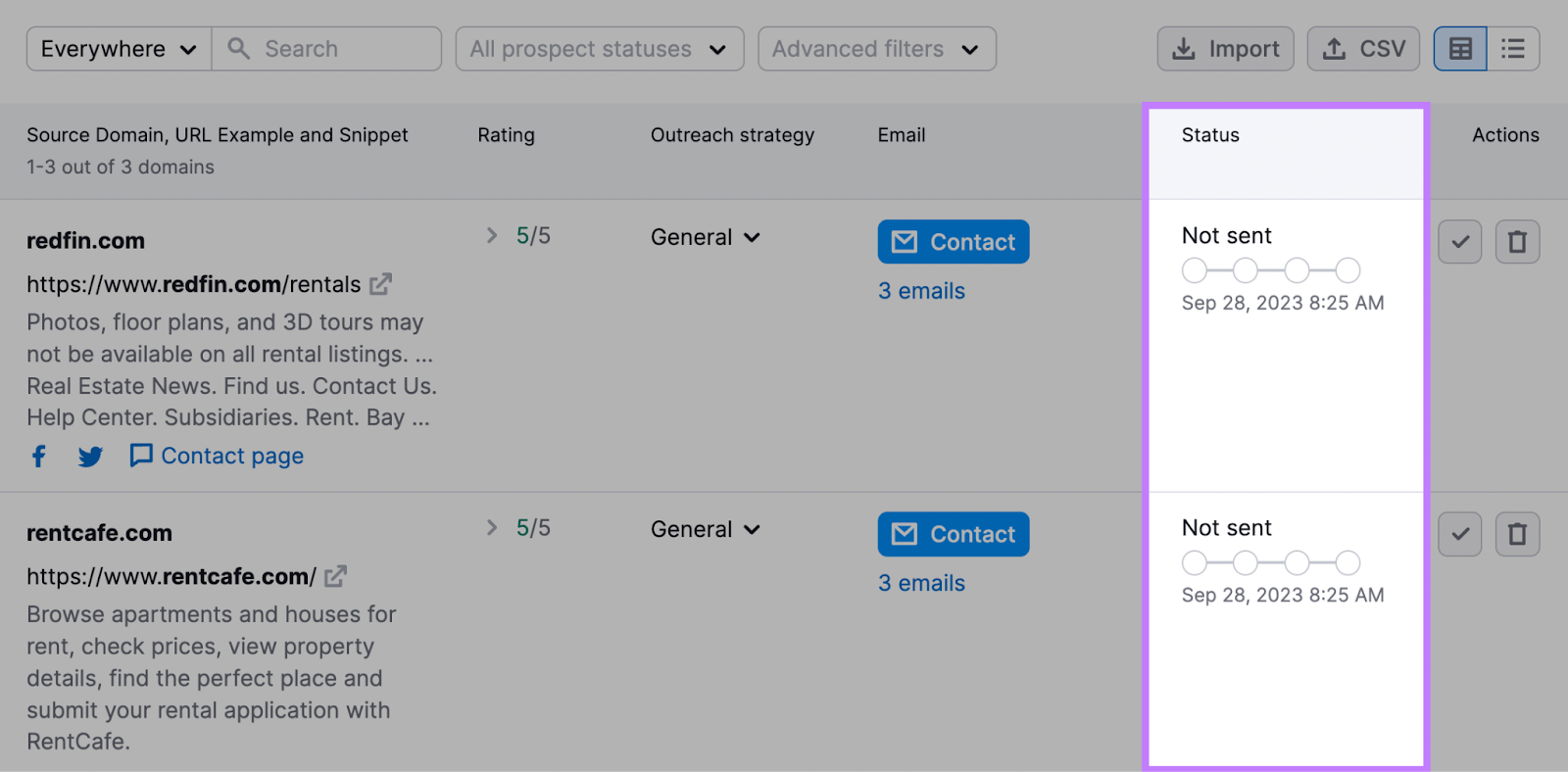
Clicking the check mark in “Actions” when you secure a backlink will help you keep track of your progress toward your KPI.
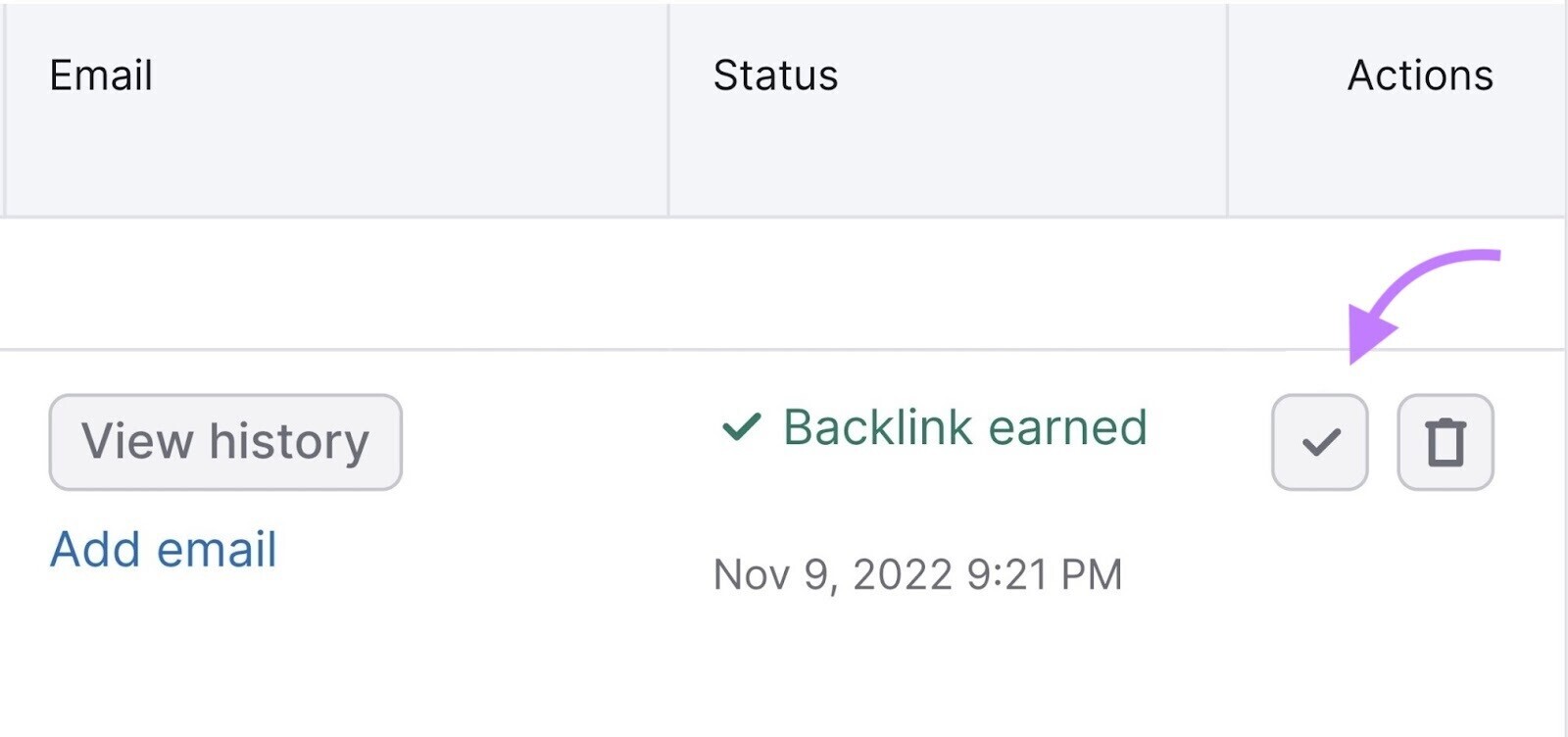
Once you do, the prospect will move over to the “Monitor” tab where you can see all of your new links.
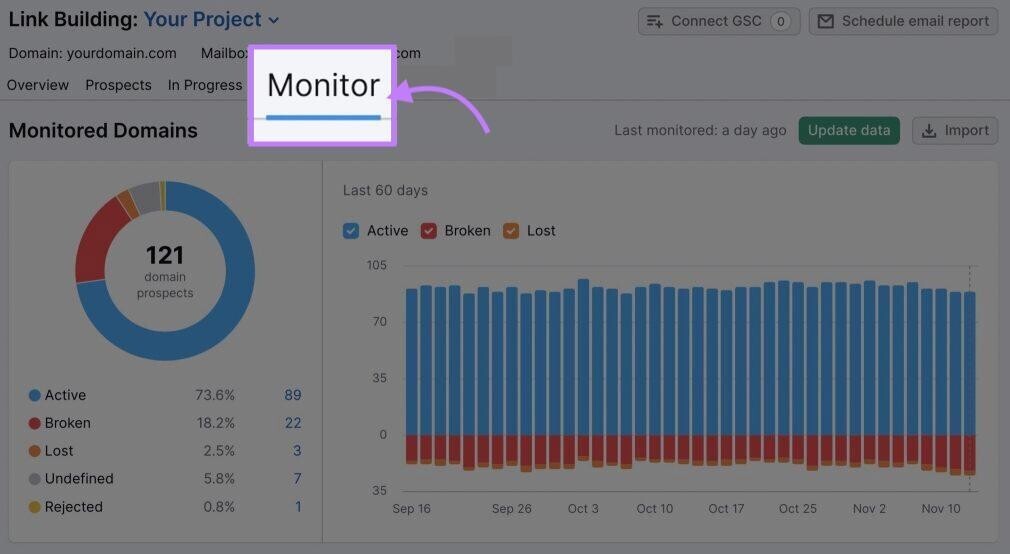
You’d go through a similar process for all of your relevant SEO goals. But just like your business objectives, make these goals and KPIs focused and specific.
Make Your SEO Goals SMART and Feasible
The SMART methodology helps clarify your ideas and focus your time and resources. Use it for your SEO goals and KPIs as well as your business objectives to ensure you’re working toward something feasible.
Instead of setting a general goal to have “more gated content,” get specific: “create and publish two high-quality 20-page ebooks per year.”
You also want to ensure your SEO goals are realistic. Look at historical data and seasonality to make sure you’re creating data-backed goals.
Let’s say you sell winter sports gear. You’re unlikely to see the same amount of traffic every quarter.
Here’s how seasonal search demand spikes for “skis” in December and January annually, then drops off:
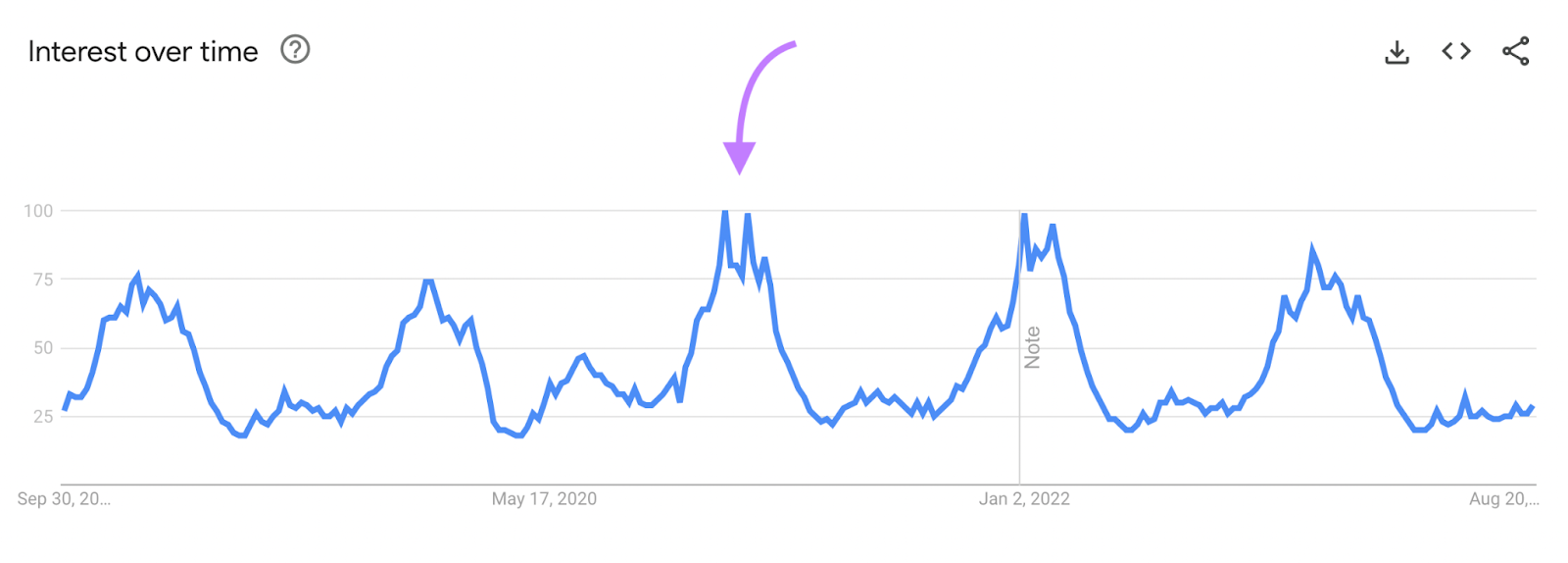
Take this data into account when setting SEO traffic goals for different quarters. Pairing SMART goals and KPIs with your benchmark, you’ll have a clear journey from point A to B within a reasonable timeframe.
Measure and Track Progress
It’s important to track progress toward your goals to see what’s working and make changes to any strategy that isn’t. This means you’re less likely to waste time or money.
Tracking your SEO goals and objectives doesn’t have to be a manual process, either.
Analytics tools like Semrush and Google Analytics can help you measure these key metrics. And how they align with business objectives as you progress.
For example, Semrush’s Position Tracking lets you track your website’s organic rankings for a custom set of target keywords.
Once you enter your domain, you can see your top keywords, rankings distribution, and where you’re having a positive and negative impact.
For example, this screenshot shows that Semrush had 97 top-three keywords, including “how to use semrush” and “semrush free tools,” on the day we captured it:

You can also use Traffic Analytics to compare your traffic to your competitors.
Enter their domains to see where traffic is coming from (e.g., direct, search, social, etc.), the traffic share between mobile and desktop, and engagement metrics like page visits and bounce rate.
For example, here are National Geographic’s SEO metrics:
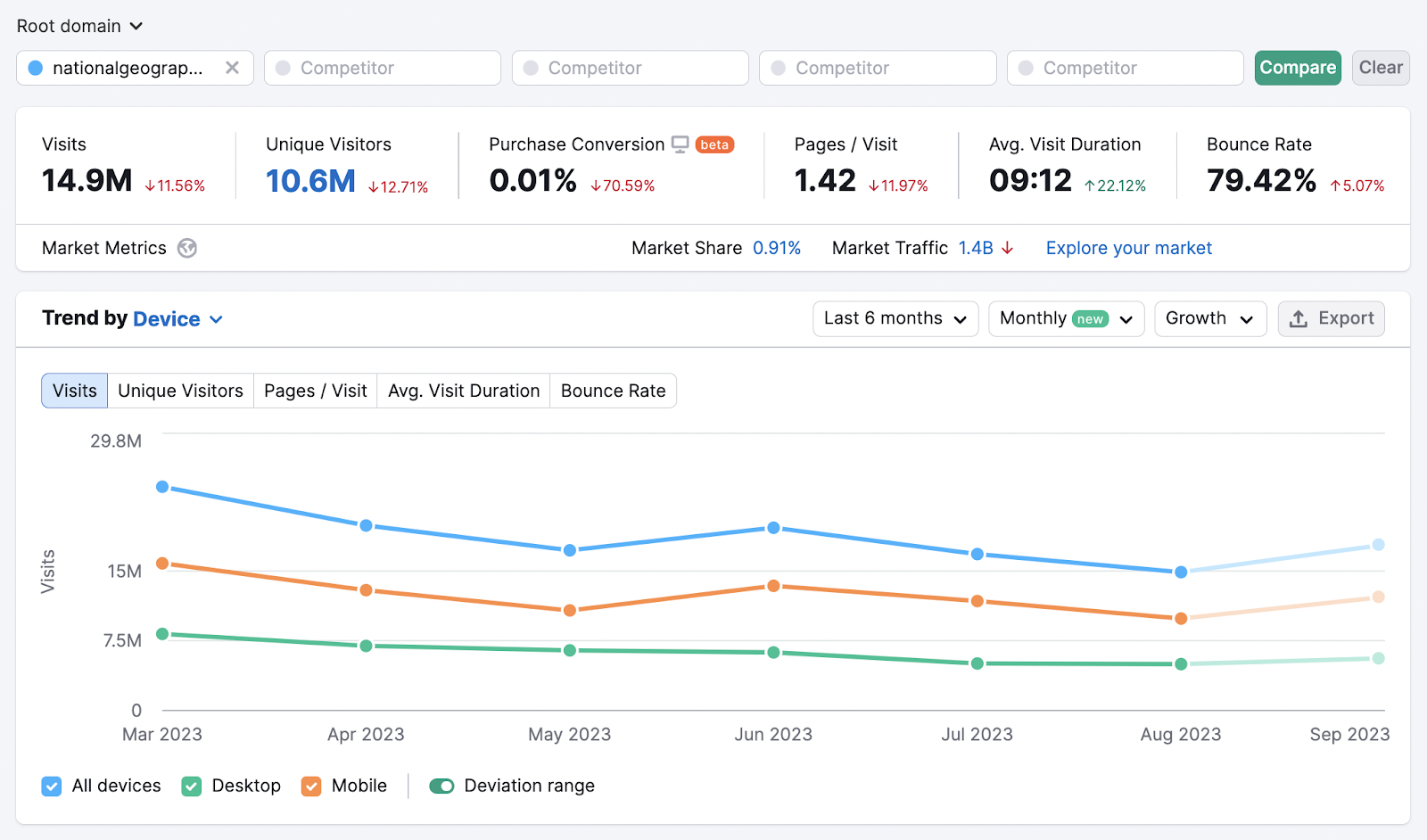
You can see the site gets a lot more traffic from mobile devices than desktop. And has seen a downturn in traffic from June to August 2023.
You can also use Google Analytics (GA4) to track all your website metrics and SEO objectives.
Setting up customized dashboards will help you monitor essential figures that relate to your SEO goals faster:

Or you can make it even easier and connect GA to your Semrush account to analyze all of your site’s data from one central location.
Communicate Results to Stakeholders
Demonstrating the value of SEO and how it’s impacting the bottom line will give it a better chance of integration into the overall business strategy.
Just like an SEO agency has to demonstrate the value of its efforts to clients, you need to do the same for your stakeholders.
That could be senior management, a department, or a business owner. Either way, effective communication builds stronger relationships and trust in the process.
So, here are some tips to keep in mind when communicating your results:
- Keep it simple: You may be used to SEO wording and jargon. But it’s up to you to explain it in simple terms for those that aren’t.
- Use visual aids: Graphs, charts, and tables can help communicate large amounts of data in a digestible way
- Clearly lay out your strategy: Detail your process and explain why you’re doing things a certain way
- Adjust for your audience: Identify what’s important to the group you’re talking to (e.g., marketing, IT, or leadership) and lean heavily on those issues
- Document everything: Business owners can struggle to trust SEO as it’s a long-term strategy without instant results. Documentation gives you credibility.
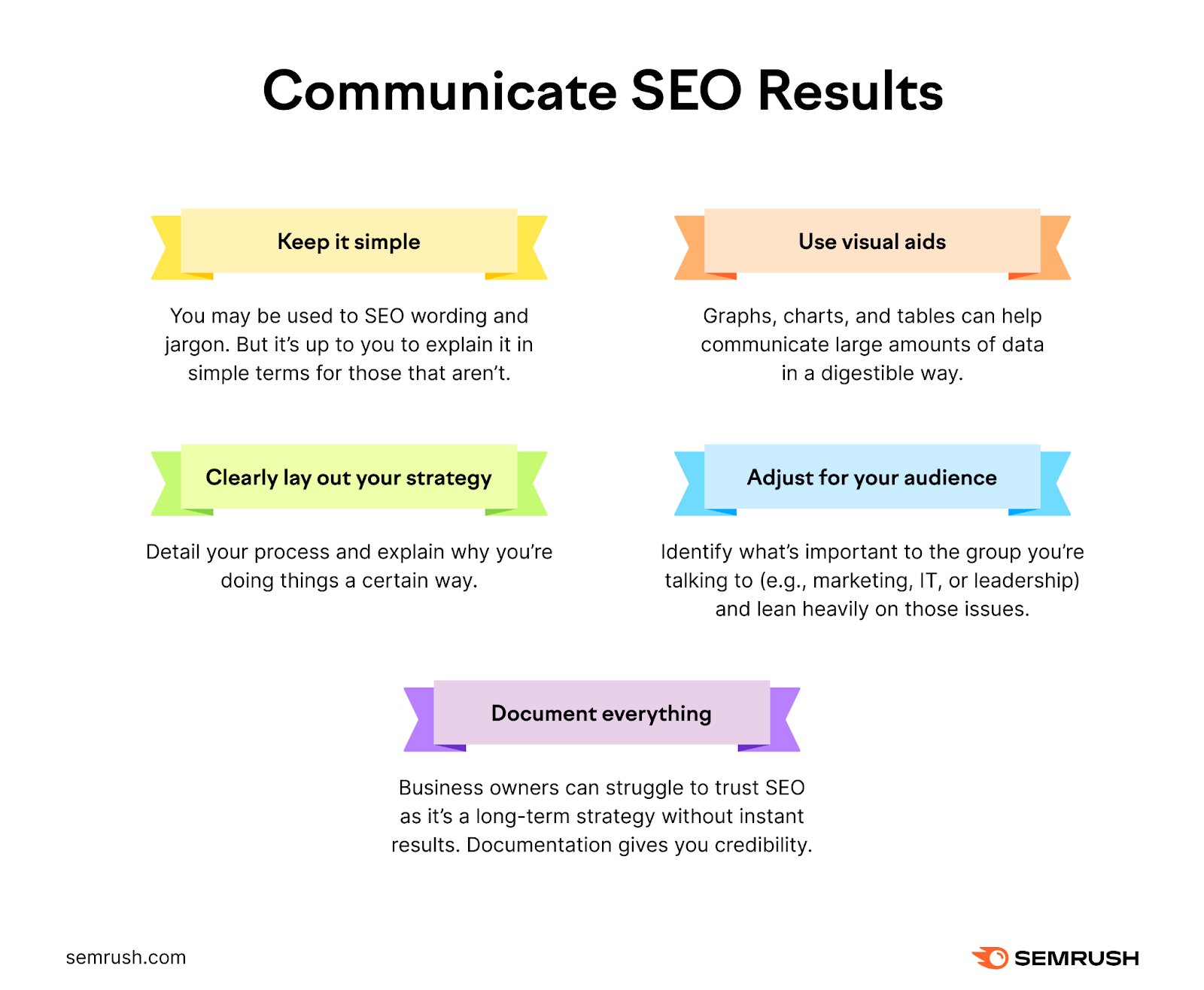
Reporting back regularly and accurately helps keep everyone on the same page. It also shows how your strategy is impacting overall business performance.
By keeping track of every strategy you’ve implemented, you can spot where you need to make changes before problems arise.
Create Your Own SEO Goals
When it’s time to create your own SEO goals, start with Semrush’s suite of tools.
If you want to create more content your audience is searching for and increase traffic, try our Keyword Magic Tool.
If you want to analyze your current backlink profile to figure out how to get more, head to Backlink Analytics.
Or, run an SEO analysis with Site Audit to uncover the highest-priority technical issues. Because an optimized, functioning website is the first step to achieving any SEO goal.
Source link : Semrush.com
